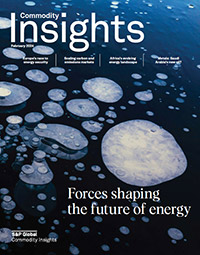Saudi Arabia’s economy has historically been dependent on oil exports, but the country is eager to diversify. Mining valuable minerals hidden under its vast deserts could help to reduce its reliance on oil and grow its share in the energy transition.
The kingdom is thought to hold significant deposits of key critical and battery metals including copper, nickel, lithium and bauxite. In January, mining CEOs and investors headed to Riyadh to attend the two-day Future Minerals Forum and rub elbows with the kingdom’s influential energy minister Prince Abdulaziz bin Salman and multiple ministers from the Ministry of Industry and Mineral Resources.
“We need to show that we are serious about change, that we can change,” said Saudi Arabia’s Minister for Industry and Mineral Resources Bandar Al-Khorayef in his opening speech on the first day of the forum in an overcrowded auditorium, alluding to previous failed attempts to get the big players of the commodities world to invest in Saudi Arabia.
In the 1990s, the government attempted to get international oil companies to develop the country’s gas resources with a $25-billion incentive. It was followed by the Rub-al-Khali non-associated gas project in 2003-2004, which also failed as upstream projects showed no results.
Now, under Saudi Arabia’s Vision 2030 – an economic, social and cultural diversification program – metals and mining are in focus.
Vision 2030 to overhaul the country
While Saudi Arabia is the biggest oil exporter in the world, its current metals and mining market is comparatively small. According to the Ministry of Mining and Mineral Resources, Saudi Arabia is a net importer and the ministry aims to change this.
As part of its Vision 2030, Saudi Arabia aims to double its current steel production output, triple its gold and copper production, and remain in the top 10 of primary aluminum producers.
Looking more closely at actual mining and metals production shows that the country will have to catch up, if it can. While there is a lot of uninhabited landmass, what can be extracted remains unknown.
The country has no current upstream production of iron ore and is producing up to 13 million mt/year of crude steel from iron ore imports. Its copper and zinc production is around 100,000 mt/year, without any current smelting or refining capabilities. The current lack of copper midstream production is particularly crucial as the country aims to speed up its electric vehicle production with a localized battery supply chain.
The aluminum value chain, on the other hand, can already be fully produced in Saudi Arabia as its biggest metals company Ma’aden is well established. The country has an annual bauxite production of 4.8 million mt, while its alumina and primary aluminum production amounts to 1 million mt/year.
In December 2023, Ma’aden said it discovered several high-density gold deposits near its existing Mansourah Massarah mine. Saudi Arabia currently mines 500,000 oz/year of gold.
Unlocking mining licenses, providing investment incentives and international roadshows with key ministers are all aimed at making Saudi Arabia a big player with negotiating power on the international stage.

Download the latest Commodity Insights Magazine. Features include:
* The future of energy
* Carbon market challenges
* Africa’s energy landscape
Unlike its status in the global oil industry, Saudi Arabia is a minnow in metals and mining when compared to giant producers in Africa and South America. Cutting regulation and red tape is a strategy to catch up.
Permits – usually a pain point for project developers – are now comparatively easy to obtain, with untapped deposits of critical minerals. Although not as big as in the Democratic Republic of Congo (DRC), the kingdom’s mineral deposits are bigger than those in Europe. For investors, it is unusual to have such a big area of uninhabited land available for mining with swift paperwork and enthusiasm from the government to attract partners.
Mining is nothing new to the kingdom from the perspective of an investor. The Saudi Arabian Public Investment Fund and investment company Manara Minerals have a 10% stake in Brazil’s Vale Base Metals.
The merged Ministry of Industry and Mineral Resources is a very young entity. It was created in 2019, carved out from the powerful Ministry of Energy as part of Vision 2030. The heads of the ministry, Minister Bandar Al-Khorayef and Vice Minister of Mining Affairs Khalid bin Saleh Al-Mudaifer, have been dubbed a “dynamic duo” in their efforts to attract investments into the sector.
Despite their enthusiasm, headwinds to developing mining in Saudi Arabia exist. The conflict in the Red Sea and the Israel-Hamas war have not necessarily impacted interest from international investors in Saudi Arabia so far, but any further escalation could push away potential miners.
The ministry announced signings of memorandums of agreement on an almost hourly basis during the Forum, with partners ranging from Finland to the DRC.
“I’m sure it was a lot of work in the lead up to the conference but they are putting a lot of pressure on themselves with these announcements,” a trading head at a major bank told S&P Global Commodity Insights.
The biggest task for the government this time is to deliver and turn the MoUs into projects. The approach under Vision 2030 looks more comprehensive than its previous attempts. But Saudi Arabia will have to continue to prove that it is serious about change by creating a framework that works for international companies to explore its untapped resources.
Whether metals and mining are the kingdom’s new oil remains to be seen.
This article first appeared in the February 2024 edition of
Commodity Insights Magazine
.



